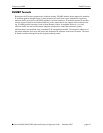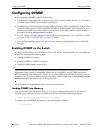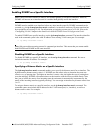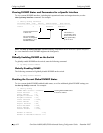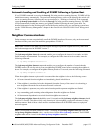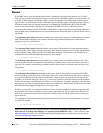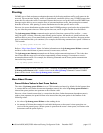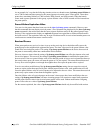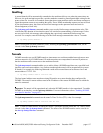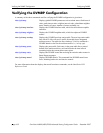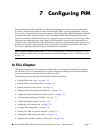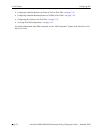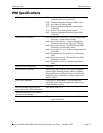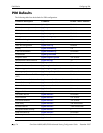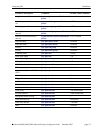
Configuring DVMRP Configuring DVMRP
page 6-16 OmniSwitch 6800/6850/9000 Advanced Routing Configuration Guide December 2007
As an example, let’s say that the following situation exists on a branch router: ip dvmrp prune-lifetime is
set to 7200 seconds and three prunes for the pruned group exist on the router’s timer queue. These three
prunes have remaining lifetimes of 7000 seconds, 5000 seconds, and 4500 seconds. When the branch
router sends a prune upstream for this group, a prune-lifetime value of 4500 seconds will be inserted into
the prune packet.
Prune-Lifetime Expiration Value
You can view the prunes that have been sent via the show ip dvmrp prune command. (However, note
that this command does not display received prunes.) The expiration time displayed by the show ip dvmrp
prune command is the earliest time that the router expects multicast traffic for the pruned group to start
arriving. If the expiration time displays as expired, the prune has expired but no further multicast traffic
has been received. The expiration value may be reset if multicast traffic is received and another prune was
sent because no stations downstream want the traffic.
Received Prunes
When prune packets are received, a timer is set up on the receiving device that halts traffic sent to the
pruned group on the neighbor that originated the prune. The timer value used is the prune-lifetime value
found in the received prune packet. The setting of ip dvmrp prune-lifetime on the device that received
the prune is not normally taken into consideration in this situation.
However, there are times when the setting of ip dvmrp prune-lifetime can affect the timeout value used
for received prunes. This occurs if the setting of ip dvmrp prune-lifetime is modified after prunes have
been received. If the new prune-lifetime value is less than the period of time a received prune has been on
the router's timer queue, the router will treat the prune as if it just expired. This means that multicast traf-
fic may flow to the neighbor even though the neighbor does not expect the prune to have expired.
Even in cases where modification of the ip dvmrp prune-lifetime setting does not cause the received
prunes to expire earlier than specified by their internal prune-lifetime value, such modification will still
cause the prune-lifetime value of received prunes to be adjusted to the new value. This means that received
prunes may expire sooner or later than the neighbor expects.
Once the lifetime value of received prunes on the router’s timer queue have been modified per the new
setting of ip dvmrp prune-lifetime, all future incoming prunes will experience normal timer operation
and the prune-lifetime value in the received prune packet will be used without modification. Outgoing
prunes will use the new value of ip dvmrp prune-lifetime.
For the reasons explained, the value of ip dvmrp prune-lifetime should only be modified with caution.




